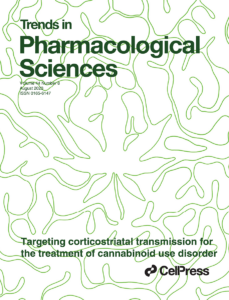 Reviews To Read – July 2023.
Reviews To Read – July 2023.
Published in Trends in Pharmacological Sciences by lead author Sergi Ferré of the NIDA IRP Integrative Neurobiology Section.
It is generally assumed that the reinforcing effects of cannabinoids are related to their capacity to induce striatal dopamine release by targeting cannabinoid receptors in the mesencephalic origin of the dopaminergic cells. In this TiPS issue, Ferré and colleagues discuss the evidence for an alternative mechanism that depends on a significant activation of frontal cortical neurons that project to the striatum. They highlight that this mechanism can provide new targets for the treatment of cannabinoid use disorder. The cover was conceptualized and designed by Daniel Guix and symbolizes the main role of the cortex in the pharmacological effects of marijuana.
Targeting corticostriatal transmission for the treatment of cannabinoid use disorder Journal Article
In: Trends in Pharmacological Sciences, vol. 44, no. 8, pp. 495-506, 2023, ISSN: 0165-6147.
